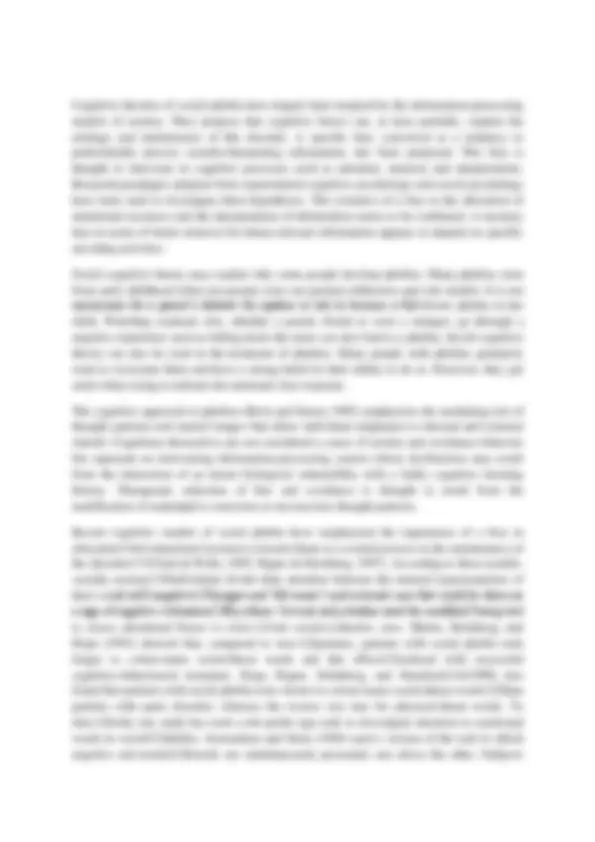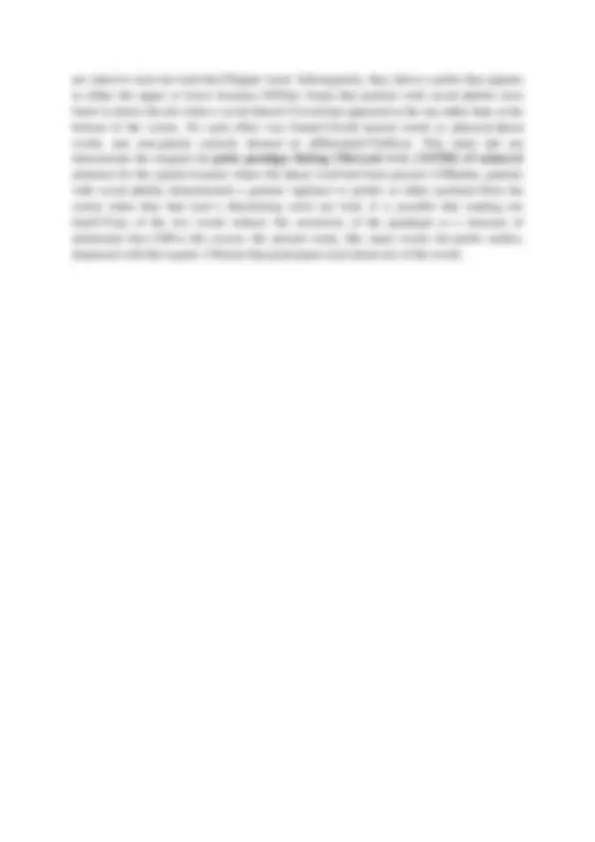




Study with the several resources on Docsity

Earn points by helping other students or get them with a premium plan


Prepare for your exams
Study with the several resources on Docsity

Earn points to download
Earn points by helping other students or get them with a premium plan
Community
Ask the community for help and clear up your study doubts
Discover the best universities in your country according to Docsity users
Free resources
Download our free guides on studying techniques, anxiety management strategies, and thesis advice from Docsity tutors
According to the behavioural approach, abnormal behaviour can be caused by: 1) classical conditioning, 2) operant conditioning and 3) social ...
Typology: Summaries
1 / 4

This page cannot be seen from the preview
Don't miss anything!



According to the behavioural approach, abnormal behaviour can be caused by: 1) classical conditioning, 2) operant conditioning and 3) social learning theory. These theories have been applied to a range of psychological disorders, most notably phobias. Although each theory can be used on its own, Mowrer (1947) put forward a two-process model, to explain how phobias are learned through classical conditioning and maintained through operant conditioning.
Classical conditioning
According to classical conditioning, phobias can be acquired through classical conditioning and associative learning.
Pavlov (1903) discovered the idea of classical conditioning in his work with dogs and in his original research, dogs learned to salivate at the sound of a bell, because they formed an association with the sound of a bell and the anticipation of food.
The bell (neutral stimulus) was associated with food (unconditioned stimulus) which resulted in the dog salivating (conditioned response) whenever a bell was rung (conditioned stimulus). This process can be used to explain the acquisition of phobias, for example, a fear of dogs.
The process of classical conditioning can explain how we learn to associate something we do not fear (neutral stimulus), for example a dog, with something which triggers a fear response (unconditioned stimulus), for example being bitten. After an association has formed, the dog (now a conditioned stimulus) causes a response of fear (conditioned response) and consequently, we develop a phobia of dogs, following a single incident of being bitten.
Watson & Raynor (1920) conducted a laboratory experiment to examine whether a fear response could be learned through classical conditioning, in humans.
Their participant wan an 11-month-old child called ‘Little Albert’. Before the experiment, Watson & Raynor noted that Albert showed no response to various different objects, in particular a white rat. In order to examine if they could induce a fear response, Watson & Raynor struck a metal bar with a hammer behind Little Albert’s head, causing a very loud noise, every time he went to reach for the rat. They did this three times. Thereafter, when they showed Little Albert the white rat, he began to cry.
This experiment demonstrated that a fear response could be induced through the process of classical conditioning, in humans. In addition, Little Albert also developed a fear towards similar objects, including a white Santa Claus beard. The experiment revealed that Little Albert had generalised his fear to other white furry objects.
Operant conditioning
Although classical conditioning can explain why we develop a phobia, it struggles to explain why our phobias do not decay over time.
For example, it is unlikely that you will be bitten by every dog you encounter and therefore it would be reasonable to assume that our phobia should weaken with every friendly dog we come across. However, most phobias are long-term and according to Mowrer, our phobias are maintained through operant conditioning.
According to operant conditioning phobias can be negatively reinforced. This is where behaviour is strengthened, because an unpleasant consequence is removed.
For example, if a person with a phobia of dogs sees a dog whilst out walking, they might try to avoid the dog by crossing over the road. This avoidance reduces the person’s feelings of anxiety and negatively reinforces their behaviour, making the person more likely to repeat this behaviour (avoidance) in the future. As a result a person will continue to avoid dogs and maintain their phobia.
Therefore, according to the two-process model, phobias are initiated through classical conditioning (learning through association) and maintained through operant conditioning (negative reinforcement).
Evaluation of classical and operant conditioning
One strength of the behaviourist explanation of phobias comes from research evidence. Watson & Raynor (1920) demonstrated the process of classical conditioning in the formation of phobias in Little Albert, who was conditioned to fear white rats. This supports the idea that classical conditioning is involved in acquiring phobias.
Cognitive Theory Basics
The assumption of cognitive theory is that thoughts are the primary determinants of emotions and behavior. Information processing is a common description of this mental process. Theorists compare the way the human mind functions to a computer.
Pure cognitive theory challenges behaviourism, another approach to psychology, on the basis that it reduces complex human behaviour to simple cause and effect.
The trend of the last decades has been to merge cognitive theory and behaviourism into a comprehensive cognitive-behavioural theory (CBT). This allows therapists to use techniques from both schools of thought to help clients achieve their goals.
Social Cognitive Theory
Social cognitive theory is a subset of cognitive theory. Therapists use it to treat phobias and other psychological disorders. It is primarily focused on the ways in which we learn to model the behaviour of others. Advertising campaigns and peer pressure situations are good examples.
are asked to read out loud the129upper word. Subsequently, they detect a probe that appears in either the upper or lower location.130They found that patients with social phobia were faster to detect the dot when a social-threat131word had appeared at the top rather than at the bottom of the screen. No such effect was found132with neutral words or physical-threat words, and non-patient controls showed no differential133effects. This study did not demonstrate the original dot-probe paradigm finding (MacLeod et al.,1341986) of enhanced attention for the spatial location where the threat word had been present.135Rather, patients with social phobia demonstrated a general vigilance to probes at either position136on the screen when they had read a threatening word out loud. It is possible that reading out loud137one of the two words reduces the sensitivity of the paradigm as a measure of attentional bias.138For this reason, the present study, like many recent dot-probe studies, dispensed with the require-139ment that participants read aloud one of the words.